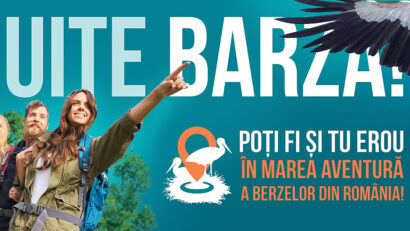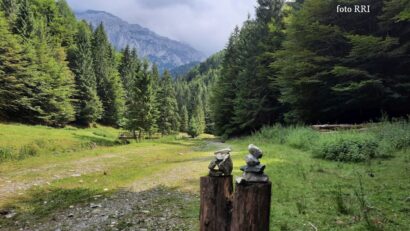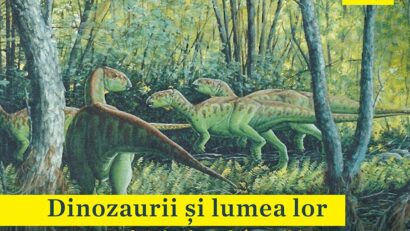Environmental education through visual art
A unique project has taken shape in the heart of the UNESCO International Geopark Țara Hațegului, at the foot of the Retezat Mountains

Daniel Onea, 28.11.2025, 12:03
A unique project has taken shape in the heart of the UNESCO International Geopark Țara Hațegului, at the foot of the Retezat Mountains. Jules Verne’s work is intertwined with environmental education on a new themed trail, inaugurated in the commune of Râu de Mori, in the village of Suseni. The “Story Trail at Colț Fortress” offers visitors a national first: discovering natural and historical heritage through comic strips, in an effort to bring young people closer to nature and reading.
In a world where technology captures the attention of the younger generations, local authorities and environmental organizations in Hunedoara County have found a creative solution to bring the public back to nature. On November 12, 2025, in the village of Suseni, a trail was officially inaugurated that transforms classic hiking into a complete visual and educational experience. This is the first themed trail in Romania interpreted through comic strips, inspired by Jules Verne’s famous novel “The Castle in the Carpathians.” The choice is not accidental, as the area is known to have been the source of inspiration for the French writer’s mysterious fortress described in the book.
The new trail is not just a simple walk through the forest, but a complex tool for environmental education. The project, funded by the Green Spaces Program – Protected Natural Areas component, places particular emphasis on raising awareness of the value of the environment. Along the one-kilometer trail, visitors encounter panels providing essential information about the biodiversity and geodiversity of the area. Dodo Niță, comic book critic and president of the Romanian Comic Book Association, was present at the inauguration and highlighted the educational value of the initiative, which goes beyond simple tourism.
“I have encountered literary themed trails in France and Belgium. For example, “In the footsteps of Tartarin in Tarascon,” and even comic strips following in the footsteps of Tintin in Brussels and throughout Belgium. However, this is the first time in Romania. It is a significant premiere, and I am very pleased to have been able to participate. For the first time, we have such a themed trail. I really liked that, from the outset, it was designed to be not only fun, but also educational. Children come to discover the Castle in the Carpathians, but on this occasion they also learn about the flora and fauna of the region, about the castle itself, about its history. I think this is absolutely extraordinary.”
The visual element that defines this route is the work of Șerban Andreescu, a renowned author and illustrator. His mission was to synthesize the action of the novel and integrate it harmoniously into the natural landscape of the Râu de Mori forest. Illustrator Șerban Andreescu confessed that the process was challenging, as he had to select key moments from a book dense with action.
“First there was the book. And because the book existed, I was able to extract certain pages from it, the most significant ones, to make a kind of summary of the book, which would then be placed along the route. I selected some of the most significant moments from the book, limited by the number of panels. In the book, almost every page is worth reading, the novel is full of action, so it was quite difficult for me to select. But I tried, that was my version of the book summary. When I arrived at the location, I already had a vision of how it would look in the end. And to my surprise, it looked exactly as I had imagined it.
Beyond the cultural aspect, the project has an important stake in the sustainable development of the area. Flaviu Dilertea, mayor of Râu de Mori, sees this trail as a catalyst for revitalizing local tourism and protecting the historical heritage represented by Colț Fortress. He added that the initiative is just the beginning of efforts to promote the area.
“We want to showcase what we have because, unfortunately, we have so many beautiful things, but we don’t know how to make the most of them. Today is a first step for the Castle in the Carpathians, for the Fortress of the Corner, so that it can be included on the list of monuments that are visited, desired, and sought after.”
The main beneficiaries of the educational dimension of the project are young people. The students present at the inauguration were delighted with the way the information is delivered: visually, quickly, and integrated into nature, unlike traditional teaching methods or textual information panels, which are often ignored. Gabriel Tonca, one of the students who completed the trail, noted the accessibility of the format.
“The idea of comics in the forest seems very interesting to me, because you can come and see a certain story without reading so much about it and see some images that are much more captivating.”
In turn, student Denisa Păta compared the trail to its previous state, highlighting the improvement in the visitor experience.
“I’ve been on this trail before, but there weren’t any signs or comics. I find it much more interesting now, and the comics are very easy to read, as are the panels.”
The organizers did not limit themselves to static panels. The trail also includes an interactive digital component. At the end of the hike, tourists are invited to discover, by scanning QR codes, two local legends in audio format and an educational activity sheet. This hybrid approach transforms a simple hike into an active learning experience. Furthermore, to ensure accessibility for international visitors, a crucial aspect for a UNESCO site, most of the information on the trail is available in two languages, Romanian and English. In addition, in the gazebo at the entrance to the trail, tourists can leave feedback, thus contributing to the future development of the project.
The UNESCO International Geopark Țara Hațegului, administered by the University of Bucharest, thus continues its series of initiatives that combine the protection of natural values with the promotion of local cultural identity. Through the “Story Trail,” Jules Verne’s legend becomes a vehicle for environmental education, demonstrating that respect for nature and culture can go hand in hand on the same mountain path. (MI)






























